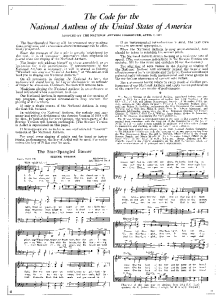MYTH #7: There is a sanctioned traditional or otherwise official version of “The Star-Spangled Banner.”
CORRECTION: The 1931 act making Key’s song America’s anthem does not identify an official arrangement, in part because the song as sung in the 20th-c. had already departed from what Francis Scott Key had known. During World War I, attempts were made to codify the arrangement, resulting in both a military “Service Version” and a “Standardized Version” endorsed by the Department of Education. That there were two competing sanctioned arrangements prevented one from dominance and, indeed, today it seems that no two performances of the anthem are ever the same.
Throughout much of the 19th century “The Star-Spangled Banner” was performed primarily as a solo song with a choral refrain repeating the final pair of lines. The song’s melodic contour was smoother (lacking, for example, the opening triadic descent on “O”) and some of the dotted rhythms common today were also missing. The original tempo marking was an upbeat and celebratory “con spirito” [with spirit], with today’s slower hymn-like maestoso becoming typical by World War II. Group singing of the whole song also was not originally common originally (at least not outside of shape not performances) such that the first published SATB arrangement did not appear until 1916.

While state laws have attempted to legislate an appropriate style and demeanor for anthem performance, no single official standard exists. A 1942 “Code for the National Anthem of the United States of America” recommends the military’s Service Version in the keys of A-flat and B-flat (click here) as the most suitable arrangement and suggests a tempo of 104 beats per minutes with the final two lines slowing to 96 beats per minute. It also requires that respect be demonstrated in performance—in careful preparation, for example, and by standing and facing the flag during singing. Unlike the flag code, the anthem code has never been adopted officially by the U.S. government, but its tenets have become traditional.
Thus musical arrangements can vary substantially. Even the different branches of the military have distinct, signature arrangements. Some of the most celebrated interpretations—such as Whitney Houston’s 1991 Super Bowl rendition—shift the song’s meter from 3/4 to 4/4. From a musician’s perspective, this change from triple to duple time utterly transforms the music’s emotional content, yet the resulting hymn-like expansion of each downbeat into a half note seems to give many listeners a feeling of reverence they find appropriate. Rather than a fault, such interpretive flexibility can be seen as concordant with values of liberty and individualism (not to mention the First Amendment). Legislating a single correct way of performing the song would eliminate confusion, but would in effect reduce patriotism to obedience.
https://youtu.be/N_lCmBvYMRs?t=38s
Whitney Houston’s celebrated performances offers the Anthem in 4/4 time
See my blogpost on the 4/4 time “tradition” here
What I’ve learned from a decade of research into Key’s anthem, and especially from the Poets & Patriots recording project that explored the roots and variants of the song in 37 different tracks, is that ‘The Star-Spangled Banner” must be performed with sincere and artful intent, not just repeated as cliché. I love that the song captures a moment in history and that it articulates a nation in the process of becoming, but more than these I love the way Key’s song speaks to us today. Unlike the flag, the Anthem must be brought to life in performance. In this way, it celebrates citizenship not as a thing, but as action. We need citizenship to sing!
What does the Anthem mean to you? For you, how is this meaning best communicated in performance?
SPANGLED MYTHCONCEPTIONS SERIES, by Mark Clague, Ph.D.
#6 Congress Made the Anthem Official | Intro | #8 Stravinsky’s “Illegal” Anthem


